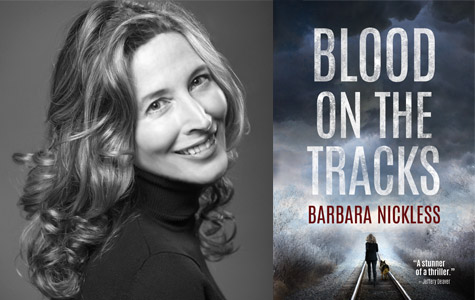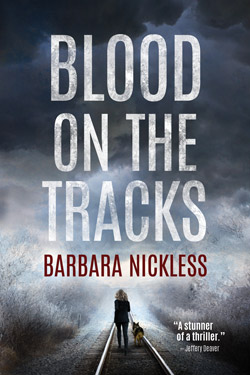
“If you want to get shot,” the SWAT leader said, “go ahead and reach for that gun.”
I froze, my hand inches from the revolver lying on the counter. Minutes earlier, I’d been full of bravado. Talking smack with my fellow drug dealers and preparing to relax on the sofa and count the day’s take. Now, looking into a pair of the coldest eyes I’d ever seen, I was suddenly unsure. Should I throw up my hands in surrender? Or go down in a blaze of glory?
My fingers twitched as my hand hovered over the gun.
“Go on,” the cop said. “I dare you.”
What I’m talking about here is not my life of crime, but the research I did in order to play the part. Crime writers have to get it right, and sometimes it’s a steep learning curve. When I set out to write my first thriller, a novel about a former-Marine-turned-railroad-cop, I had to convincingly depict guns, murder investigations, trains, railroad cops, the CIA, the Iraq War and Mortuary Affairs, the Marines, military working dogs, K9s, hobos, railroad gangs, and skinheads. And that was just the start.
When writers create a work of fiction, they hope to beguile readers into suspending their disbelief. Research plays a big part in this. Readers can tell when an author knows what they're talking about, and they see right through any attempt to shine them on. I conduct mountains of research in the hope that my stories will ring true.
But is it all about the difference between an M16 and an AK-47? Hemingway advised, “Write the truest sentence you know.” Which, for me, means going beyond simply getting the facts straight. It means creating believable characters who stand up from the page. One of my favorite authors, Alexandra Fuller, says that while she was writing The Legend of Colton H. Bryant, she so inhabited Colton’s Wyoming world that she set a place for him at the dinner table every night. That’s creating character.
 When I set out to write Blood on the Tracks, I knew my biggest challenge would be finding a way to get inside the head of my protagonist. Special Agent Sydney Parnell grew up in a blue-collar railroading family, was orphaned at a young age, then joined the Marines and served in Iraq where she processed the dead. Her life was a world apart from my own.
When I set out to write Blood on the Tracks, I knew my biggest challenge would be finding a way to get inside the head of my protagonist. Special Agent Sydney Parnell grew up in a blue-collar railroading family, was orphaned at a young age, then joined the Marines and served in Iraq where she processed the dead. Her life was a world apart from my own.
So, a lot of research was in order. In an effort to understand what makes people like Parnell tick, I studied post-traumatic stress disorder: its history, how it manifests and is treated, and the controversy surrounding some of those treatments. I also worked hard to imagine what it is like to go to war and then come back home, how daily life plays out when you’re a female in the hyper-masculine Marine culture, and—as ugly as it sounds—what you feel before, during, and after you kill someone. Creating Sydney Parnell was a tall order!
For other characters in the book, I dug into stories written by and about neo-Nazis. I learned what it means to be severely burned over a large part of your body and how it is to carry those scars for the rest of your life. I worked to grasp the subtext as well as the overt conditions of being poor and homeless and desperate in America. And, in order to sympathize with the victims in my novel, I read stories about people who’d endured natural disasters, war, or had been victims of crimes.
So how far will I go to get it right? And am I certifiably crazy to do some of the things I do? Maybe. While I’ve stopped short of trying to jump onto a moving train (don’t ever, ever, ever try this), I have observed dead bodies, shared a gun range with someone who had no idea what he was doing (and who didn’t let that stop him from waving his weapon around), watched K9s take down criminals while I scrambled to get out of the way, and had my clothes cut away before I was repeatedly showered with ice-cold water during a disaster simulation. In order to understand a character’s world view, I’ve shot bad guys in interactive video real-world simulators, then revisited the scenario in my mind for hours afterward. When I fired my gun, did I do the right thing? Is this a small taste of what it feels like for law enforcement officers when they discharge their weapon in the line of duty?
During a single night of riding shotgun with a sheriff’s deputy, I found myself standing just inside the front door of a house belonging to a domestic violence victim, then scrambling for cover when the doorbell rang; the offender had sworn to come back with a gun. I watched kids get busted for drugs, sat with a terrified home owner while the deputy investigated a suspicious noise on her lonely, sprawling property, waded through a single-car accident that left a car nose-down in a deep ditch, and was accidentally locked in the back of a cruiser during a murder investigation.
For the next book in my series, Dead Stop, I’ve continued with a lot of the same research, but I’ve added new elements. That book will feature the FBI, the dark web, child abduction, and serial killers. So I’ve gone to lectures on serial killers and the internet, attended the incredible and eye-opening FBI Citizens’ Academy, and interviewed agents and officers on the intricacies of searching for a stolen child.
Back to that small home and the gun lying on the counter. When the door burst open and twelve SWAT officers poured in—swathed head to toe in black body armor, assault rifles at the ready and aimed at me—I lost my courage completely. All I could see of them were their eyes, and the look in those eyes meant business. My hands went up in surrender, the gun stayed on the counter, and I missed my chance to get shot. With a paintball gun.
For photos of some of my research and a partial bibliography of my resources, please visit my website at www.barbaranickless.com. Or connect with me on Twitter @BarbaraNickless or on Facebook @barbaraNnickless.
To learn more or order a copy, visit:
opens in a new window![]() opens in a new window
opens in a new window![]()
Barbara Nickless has always been interested in things that might get her killed, or at least maimed. She’s rehabilitated wild birds of prey, explored little-known caves, handled rattlesnakes, and raised two children through their teenage years. Her bestselling debut novel, Blood on the Tracks, is how she imagines life would be for Harry Bosch—if he were a railroad cop with a death wish.

I froze, my hand inches from the revolver lying on the counter to see from
[url=http://www.an-la-crime-story.com/]Best Romantic Mystery Novels[/url]. Minutes earlier, I’d been full of bravado. Talking smack with my fellow drug dealers and preparing to relax on the sofa and count the day’s take.
WOAH!
That was a fantastic read. Thanks for sharing… +1 for Best Romantic Mystery Novels.
From skincare and hygiene tips to lifestyle and fashion advice, there are plenty of ways for you to both look and feel your best. We’ve put together 16 tips to help you get started.